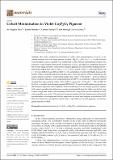Por favor, use este identificador para citar o enlazar a este item:
http://hdl.handle.net/10261/279585COMPARTIR / EXPORTAR:
 SHARE SHARE
 CORE
BASE CORE
BASE
|
|
| Visualizar otros formatos: MARC | Dublin Core | RDF | ORE | MODS | METS | DIDL | DATACITE | |

| Título: | Cobalt minimisation in violet Co3P2O8 pigment |
Autor: | Tena, M. A.; Mendoza-Meroño, Rafael CSIC ORCID; Trobajo, Camino CSIC ORCID; García-Granda, Santiago CSIC ORCID | Palabras clave: | Minimisation of toxicity Pigments Co3P2O8 Solid solutions α-Mg3P2O8 |
Fecha de publicación: | 2022 | Editor: | Multidisciplinary Digital Publishing Institute | Citación: | Materials 15(3): 1111 (2022) | Resumen: | This study considers the limitations of cobalt violet orthophosphate, Co3P2O8, in the ceramic industry due to its large amount of cobalt. MgxCo3−xP2O8 (0 ≤ x ≤ 3) solid solutions with the stable Co3P2O8 structure were synthesised via the chemical coprecipitation method. The formation of solid solutions between the isostructural Co3P2O8 and Mg3P2O8 compounds decreased the toxically large amount of cobalt in this inorganic pigment and increased the melting point to a temperature higher than 1200 °C when x ≥ 1.5. Co3P2O8 melted at 1160 °C, and compositions with x ≥ 1.5 were stable between 800 and 1200 °C. The substitution of Co(II) with Mg(II) decreased the toxicity of these materials and decreased their price; hence, the interest of these materials for the ceramic industry is greater. An interesting purple colour with a* = 31.6 and b* = −24.2 was obtained from a powdered Mg2.5Co0.5P2O8 composition fired at 1200 °C. It considerably reduced the amount of cobalt, thus improving the colour of the Co3P2O8 pigment (a* = 16.2 and b* = −20.1 at 1000 °C). Co3P2O8 is classified as an inorganic pigment (DCMA-8-11-1), and the solid solutions prepared were also inorganic pigments when unglazed. When introducing 3% of the sample (pigment) together with enamel, spreading the mixture on a ceramic support and calcining the whole in an electric oven, a colour change from violet to blue was observed due to the change in the local environment of Co(II), which could be seen in the UVV spectra of the glazed samples with the displacement of the bands towards higher wavelengths and with the appearance of a new band assigned to tetrahedral Co(II). This blue colour was also obtained with Co2SiO4, MgCoSiO4 or Co3P2O8 pigments containing a greater amount of cobalt. | Descripción: | This article belongs to the Special Issue Advances in Phosphate Materials: Structural, Technological and Biomedical Applications. | Versión del editor: | https://doi.org/10.3390/ma15031111 | URI: | http://hdl.handle.net/10261/279585 | DOI: | 10.3390/ma15031111 | E-ISSN: | 1996-1944 |
| Aparece en las colecciones: | (CINN) Artículos |
Ficheros en este ítem:
| Fichero | Descripción | Tamaño | Formato | |
|---|---|---|---|---|
| cobalpigm.pdf | 2,99 MB | Adobe PDF |  Visualizar/Abrir |
CORE Recommender
PubMed Central
Citations
2
checked on 17-abr-2024
SCOPUSTM
Citations
5
checked on 28-abr-2024
WEB OF SCIENCETM
Citations
4
checked on 26-feb-2024
Page view(s)
36
checked on 01-may-2024
Download(s)
76
checked on 01-may-2024

